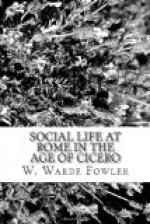The temple had been destroyed by fire in the time of Sulla, and its restoration was not as yet finally completed at the time of our imaginary walk.[34] It faced towards the river and the Aventine, i.e. south-east, according to the rules of augural lore, like all Roman public buildings of the Republican period. From the platform on which it stands we look down on the Forum Boarium, from which we started, connected with the Forum by the Velabrum and the vicus Tuscus; and more to the right below us is the Campus Martius, with access to the city by that Porta Carmentalis which Evander showed to Aeneas. This spacious exercise-ground of Roman armies is already beginning to be built upon; in fact the Circus Flaminius has been there for more than a century and a half, and now the new theatre of Pompeius, the first stone theatre in Rome, rises beyond it towards the Vatican hill. But there is ample space left; for it is nearly a mile from the Capitol to that curve of the Tiber above which the Church of St. Peter now stands; and on this large expanse, at the present day, the greater part of a population of nearly half a million is housed. I do not propose to take the reader farther. We have been through the heart of the city, as it was at the close of the Republican period, and from the platform of the great temple we can see all else that we need to keep in mind in these chapters.
CHAPTER II
THE LOWER POPULATION (PLEBS URBANA)




